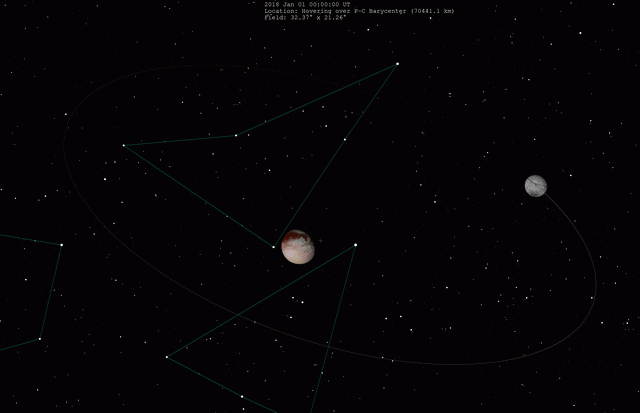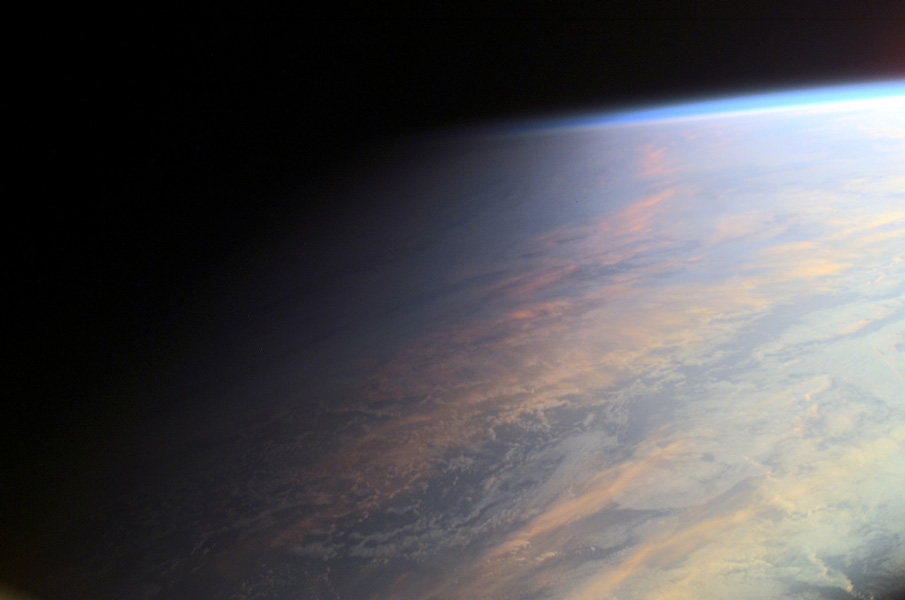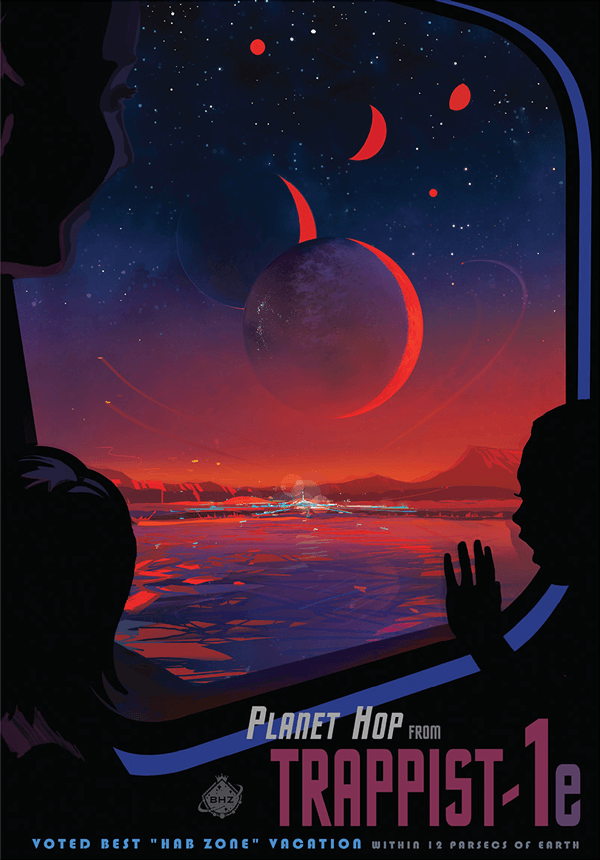On some worlds, the sun never sets. Or rises. If a planet takes the same amount of time to spin once about its axis as it does to orbit once about its parent star, that star will appear to hang motionless in the sky. Such planets show only one face to their star, a situation known as tidal locking.
A tidally locked planet is a bifurcated world. On one side it’s always day; on the other, eternal night. The boundary between features a thin ring of twilit eternity, where the sun is forever setting (or rising, if you prefer). A number of worlds in our own solar system are tidally locked — including our moon — and any number of exoplanets that orbit their own stars in other solar systems may be tidally locked as well.
When gravitational forces slow or accelerate the rotation of an astronomical body it can become tidally locked to its parent body (in this example, a planet is tidally locked to its star). Under these conditions the orbiting body always shows the same face to its parent body. Our moon is tidally locked to Earth and scientists suspect that many exoplanets orbiting relatively close to their stars may also be tidally locked.
Many of these planets will be inhospitable, baked on one side and frozen on the other. Yet astronomers have long contemplated whether such worlds might harbor life, as have sci-fi enthusiasts. Now sophisticated computer modeling and new data are illuminating more about the atmospheres of these tidally locked, distant worlds. The research is adding weight to the notion that some may not be so hostile.
“There’s nothing really especially bad about tidal locking,” says physicist Raymond Pierrehumbert of the University of Oxford in England. “The day side is perfectly good habitat and there’s quite a lot of it.”
Slowing the spin
For a nearby example of tidal locking we need only look up: Our moon is tidally locked to the Earth, the result of a gradual slowing of the moon’s rotation over millions of years due to gravitational interactions with our planet. Just as the moon’s gravity sloshes our oceans back and forth to create tides (hence “tidal locking”), a star’s gravity pulls on the rocky body of an orbiting planet, creating a bulge.
If a planet is rotating either faster or slower than the pace at which it orbits its star, that bulge will be slightly off-center. Over time, the tug of the star’s gravity on the misaligned bulge will gradually slow or boost a planet’s spin until they reach an equilibrium: The planet will rotate on its axis exactly once for every time it circles its star.
The effect is most pronounced on worlds that are very close to their orbital companions, which is why the moon is tidally locked to the Earth, but the Earth isn’t tidally locked to the sun.
Pluto and its moon Charon also show only one face to each other — they orbit so closely and are similar enough in size that tidal forces synced both of their rotations.
While astronomers don’t have an exact count of the number of tidally locked worlds, it’s “a basic expectation” that many exoplanets are gravitationally bound to their stars in this way, says planetary scientist Daniel Koll of MIT.

Pluto and its moon Charon, depicted here from a side view, are tidally locked to each other. Typically, an orbiting body is tidally locked to a larger body, but Pluto and Charon are similar enough in size and close enough in distance that each is tidally locked to the other.
CREDIT: TOMRUEN / WIKIMEDIA COMMONS
Many of these bodies will be places of extremes, at once both roasted and frozen. Consider a large rocky exoplanet called 55 Cancri e, which orbits its sunlike G-type star about once every 18 hours.
“It’s so hot you have a permanent magma ocean on the day side,” says Pierrehumbert, who describes the atmospheres of tidally locked worlds in a recent Annual Review of Fluid Dynamics. “And then you get rock vapor that evaporates into the atmosphere and then condenses out toward the nightside. So you have rain made out of silicon monoxide and things like that.”
But a tidally locked planet with an atmosphere something like Earth’s might redistribute heat fairly efficiently, says Koll. The result could be environments amenable to life — a longtime goal of planet hunters.
Air and water
Around the turn of the last century, astronomers erroneously thought that Venus might be tidally locked. “Between the two separate regions of perpetual night and day there must lie a wide zone of subdued rose-flushed twilight, where the climatic conditions may be well suited to the existence of a race of intelligent beings,” wrote E.V. Heward in 1903.
Optimism regarding the habitability of the “twilight zone” also emerged in the world of science fiction, says University of Chicago geophysicist Dorian Abbot. The idea was that the region between the planet’s light and dark side would be mild enough for water to exist in liquid form and perhaps allow life to survive.
Research has cast doubt on that theory. The twilight zone — which astronomers call the “terminator” — would be a poor place for organisms that need the sun’s light to survive.

Twilight, the gradual transition from day to night, shown here from above Earth, has captured people’s imagination as a place that might support life on exoplanets. But a twilight zone, or the terminator in astronomy parlance, may not be the only habitable portion of an exoplanet if it has a suitable atmosphere.
CREDIT: ISS EXPEDITION 2 CREW / GATEWAY TO ASTRONAUT PHOTOGRAPHY OF EARTH / NASA
But you don’t need a twilight zone to support life if you have the right atmosphere, says Abbot.
An atmosphere transports heat around the planet, making conditions that could support liquid water — and perhaps life — more widespread. “It wouldn't just be at the terminator,” Abbot says, “it would be all over the place.”
There’s a balancing act: The atmosphere needs to be dense enough to transport heat, but not so dense as to become smothering. Conversely, if the nightside becomes too cold, it could freeze the gases out, stealing an atmosphere entirely.
A 2016 simulation developed by Abbot and Koll indicates that the right balance is achievable: Some tidally locked exoplanets could host “just right” atmospheres that move heat around efficiently enough to keep even the night side warm.
“It would be strange because it would be permanently night but you might still have conditions where life similar to ours could exist,” says Koll. Consider the poles on Earth, where life persists, even though sunlight is scarce. “It doesn’t get too deadly cold, in great part because wind or motions of the ocean actually redistribute heat.”
On Earth, oceans are key players in the global circulation of heat; water holds more heat energy than air and is far more efficient at moving that heat around. So, along with an atmosphere, oceans could play an important role in keeping the day and night sides of a tidally locked exoplanet temperate.
Oceans also lead to evaporation, spurring the formation of clouds that can also play an important role in regulating conditions on a planet, says Feng Ding, a researcher at Harvard studying exoplanet atmospheres. Clouds that form as water collects in the atmosphere can serve as a kind of reflective blanket, bouncing incoming stellar radiation back out and helping to cool a planet.
Some computer simulations suggest that clouds could keep temperatures low enough for oceans to form even on exoplanets that might otherwise be boiling hot. And those clouds would create rain. On the planet’s day side, strong updrafts created where sunlight is most intense would move warm, wet air upwards, creating torrential rainstorms, says Pierrehumbert.
Land and life?
That rain could help regulate a tidally locked exoplanet’s temperature, especially if there’s also land. On Earth, rain reacts with exposed rock, trapping some carbon as a mineral and removing it from the atmosphere, which helps cool the planet. Over time, this chemical weathering could also keep carbon dioxide levels manageable on a tidally locked planet, Pierrehumbert says.
Other atmospheric gases could also make an exoplanet more hospitable, he speculates. Nitrogen, for example, helps prevent water loss by trapping it lower in the atmosphere, where it’s exposed to fewer ultraviolet rays that break water vapor apart into oxygen and hydrogen. A nitrogen-laden atmosphere would help maintain the liquid oceans that serve as key regulators of temperature.

This lighthearted NASA space tourism poster features the exoplanets orbiting the red dwarf star TRAPPIST-1. Each of the seven planets that orbit the dim red dwarf star are thought to be tidally locked to the star. The tourists are taking in TRAPPIST-1e, which is in the star’s habitable zone, making it the most likely TRAPPIST-1 planet to support liquid water.
CREDIT: NASA-JPL / CALTECH
Scientists can feed many of these variables into computer simulations, but much of exoplanet atmospheric research is speculative. Studies of tidally locked bodies are no exception. For one thing, data that would ground-truth all these variables are scarce. And, says Koll, most exoplanet atmosphere astronomy has been confined to planets that don’t look much like Earth. They are much larger and are often covered by thick atmospheres, like Neptune and Uranus.
But new instruments, such as NASA’s Transiting Exoplanet Survey Satellite (TESS) will greatly expand the number of exoplanets that have been detected. And when NASA’s James Webb Space Telescope finally launches in 2021 — pending possible delays due to the coronavirus pandemic — it will allow for even more detailed observations of exoplanets, including data on the composition of their atmospheres.
Those data will help astronomers refine their models and better understand the conditions that could make any planet habitable — including far-off, tidally locked ones. With potentially trillions of exoplanets in existence, there might be one with shallow oceans where life could form, balmy continents where organisms grow or crawl and an atmosphere where they might take to the skies. There, under the eternal light of an ever-present alien sun, life could prosper.




